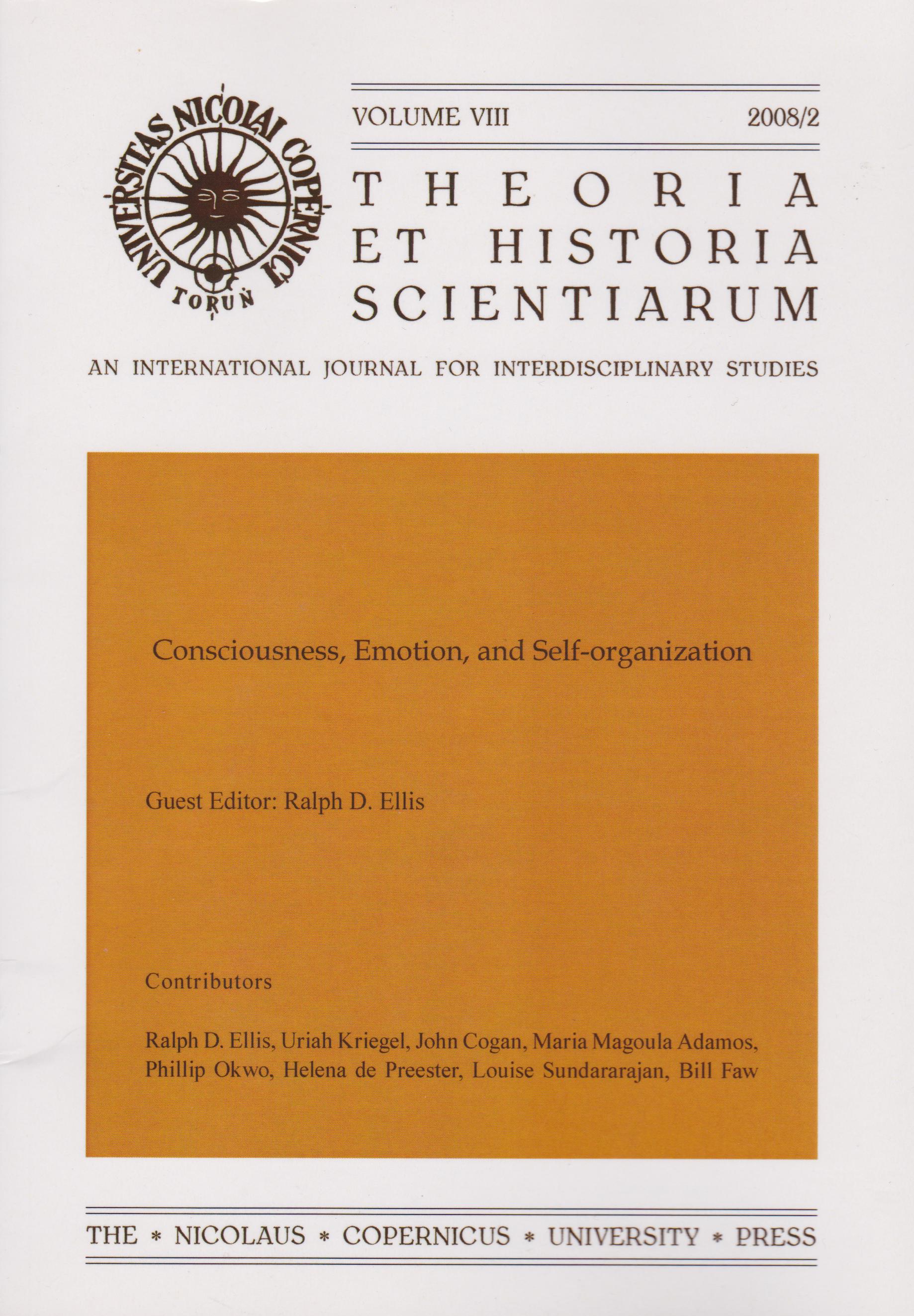A Neuro-Psychological Model of Emotion
DOI:
https://doi.org/10.12775/ths.2008.015Keywords
psychology, neurology, model of emotions, neuro-psychological modelAbstract
A standard approach in physiological and neurological psychology is to try to find “neural correlates” to various folk-psychological and scientific-psychological phenomena. For instance, we believe we have some understanding of “consciousness” or “working memory” or “components of emotion”. Then we look to see what “centers” and “circuits” and “neurotransmitters” underlie those processes. This traditional approach is to move from the psychological to the neurological. This approach has been quite successful.
References
Adrianov, O.S. 1996. Cerebral interrelationships of cognitive and emotional activity: Pathways and mechanisms. Neuroscience & Behavioral Physiology, 26(4), 329-339.
Agggleton, J.P., Burton, M.J. & Passingham, R.E.. 1980. Cortical and subcortical afferents to the amygdala of the rhesus monkey (macaca mulatta). Brain Research 190, 347- -368.
Aggleton, J.P. 2000. (Ed). The Amygdala: Second Edition: A Functional Analysis, Oxford: Oxford University Press.
Cannon, W. 1929. Bodily Changes in Pain, Hunger, Fear and Rage: An Account of Recent Researches into the Function of Emotional Excitement. New York: D. Appleton.
Carlson, N.R. 1992. Foundations of Physiological Psychology, 2"d ed. Boston: Allyn & Bacon
Descartes, R. 1649/1998. The Passions of the Soul. In J.F. Brennan (ed). Reading in the History and Systems of Psychology, 2nd ed., pp 53-65. Upper Saddle River, NJ: Prentice Hall.
Ellis & N. Newton (Eds.), Caldron of Consciousness (pp. 55-90), Amsterdam: John Benjamins Publishers.
Farah, M.J. 1984. Neurological basis of mental imagery: Componential analysis. Cognition, 18, 245-272.
Faw, Bill. 1997. Outlining a brain model of mental imaging abilities. Neuroscience and Biobehavioral Reviews 21(3), 283-288.
Faw, B. 2000a. Consciousness, motivation and emotion: Biopsychological reflections. In R.D.
Faw, B. 2000b. My amygdala-orbitofrontal-circuit made me do it. Consciousness and Emotion, 111, 167-179.
Faw, B. 2003. Pre-frontal executive committee for perception, working memory, attention, long-term memory, motor control, and thinking: A tutorial review. Consciousness and Cognition, 12, 83-139.
Figdor, C. 2003. Can mental representations be triggering causes? Consciousness & Emotion. Vol 4/1, pp 43-61.
Frith, C. 2001. Attention to action and awareness of other minds. Paper at 5,11 Annual Meeting Association for the Scientific Study of Consciousness. Durham, N.C.
James, W. 1884. What is an emotion? Mind 9:188-205.
Lange, Carl. 1885/1922. In James and Lange: The Emotions. Baltimore
LeDoux, J.E., Iwata, J., Cicchetti, P. & Reis, D.J. 1988. Different projections of the central amygdaloid nucleus mediate autonomic and behavioral correlates of conditioned fear. Journal of Neuroscience, 8, 2517-2529.
LeDoux, J. 2000. The amygdala and emotion: a view through fear. In J. P. Aggleton (Ed). The Amygdala: Second Edition: A Functional Analysis, Oxford: Oxford University Press, pp. 289-310.
Martindale, C. 1991. Cognitive Psychology: Neural-Network Approach. Pacific Grove, CA: Brooks/Cole.
Miyashita, Y. 2000. Visual associative long-term memory: Encoding and retrieval in inferotemporal cortex of the primate. In Gazzaniga, M.S. (Ed.) New Cognitive Neurosciences: Second Edition. Cambridge, MA: MIT Press, pp 379-392.
Murray, E.A. 2000. Memory for objects in nonhuman primates. In Gazzaniga, M.S. (Ed.) New Cognitive Neurosciences: Second Edition. Cambridge, MA: MIT Press, pp 753- -763.
Panksepp, J. 2000. Affective consciousness and the instinctual motor system: The neural sources of sadness and joy. In R.D. Ellis & N. Newton (Eds.), Caldron of Consciousness (pp. 27-54), Amsterdam: John Benjamins Publishers.
Posner, MI.& DiGirolamo, G.J. 2000. Attention in cognitive neuroscience: Overview. In Gazzaniga, M.S. 2000 (Ed.) New Cognitive Neurosciences: Second Edition. Cambridge, MA: MIT Press, pp 623-631.
Raichle, M. 2001. Default mode of brain function: Finding the neural baseline of consciousness. Paper at 5,h Annual Meeting Association for the Scientific Study of Consciousness. Durham, N.C.
Schachter, S. 1964. The Interaction of cognitive and physiological determinants of emotional state. In Berkowitz L. (ed.), Advances in Experimental Social Psychology, Vol 1. New York: Academic Press.
Solomon, R. 1976. The Passions. Garden City, NY: Anchor Press/Doubleday.
Squire, L.R. & Knowlton, B.J. 2000. Medial temporal lobe, the hippocampus, and the memory systems of the brain. In Gazzaniga, M. (Ed.) New Cognitive Neurosciences: Second Edition. Cambridge, MA: MIT Press, pp 765-779.
Tulving, E. 1991. Concepts of human memory. In Memory: Organization and Locus of Change, (Eds.) Squire, L.R., Weinberger, N.M., Lynch, G. & McGaugh, J.L. New York: Oxford University Press.
Tulving, E. 2000. Introduction to the section on Memory In Gazzaniga, M. (Ed.) New Cognitive Neurosciences: Second Edition, Cambridge, MA: MIT Press, pp 727- 732.
Watson, J. & Rayner, R. 1920. Conditioned emotional reactions. Journal of Experimental Psychology, 3, 1-14.
Downloads
Published
How to Cite
Issue
Section
Stats
Number of views and downloads: 437
Number of citations: 0



